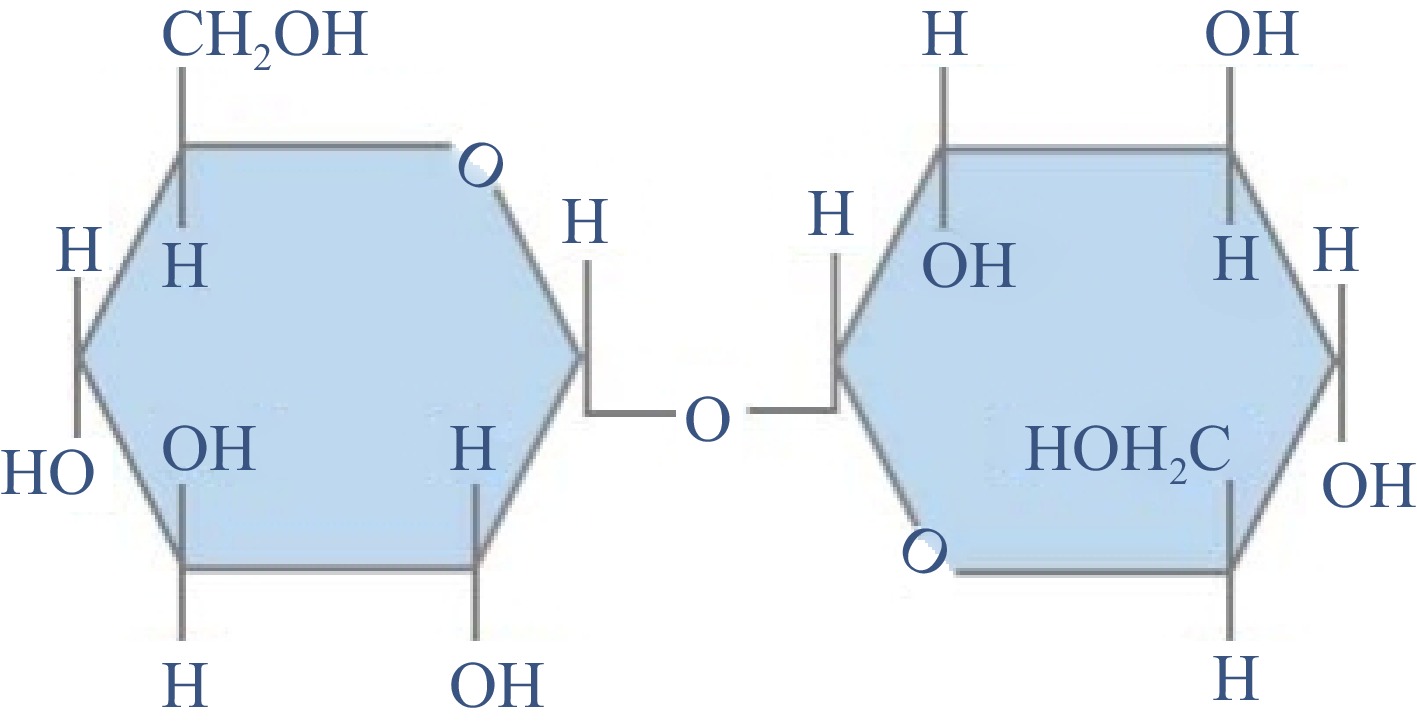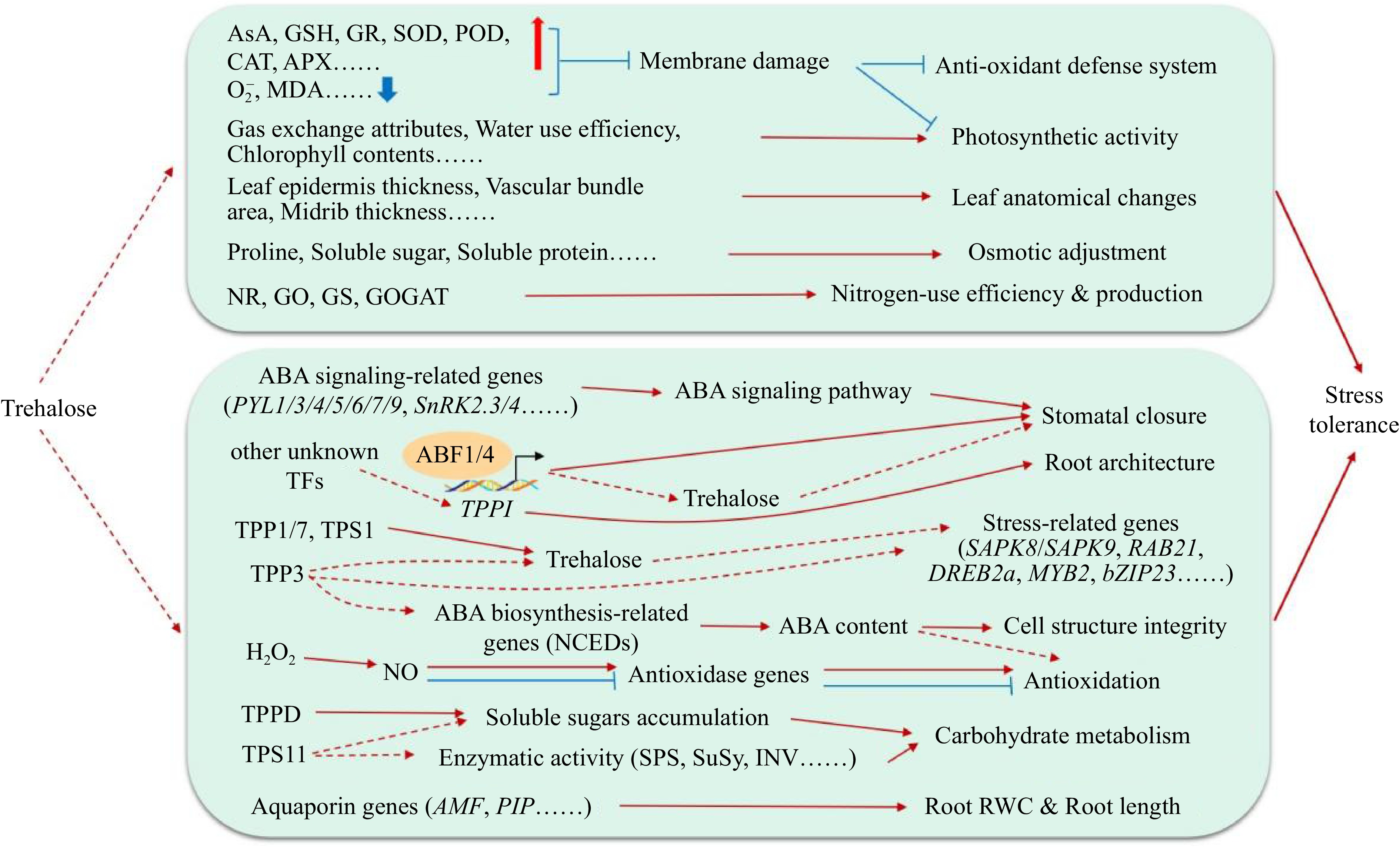-

Figure 1.
Chemical structure of trehalose.
-

Figure 2.
Synthesis and degradation of trehalose.
-

Figure 3.
Function of trehalose in plant growth and development.




-

Figure 4.
Function of trehalose in the abiotic stress response of plants.




${\text{O}^-_2} $ -
Stress types Regulatory mechanisms Species Treatments References Drought stress Enhance antioxidant capacity Zea mays 0 and 30 mM Tre spraying plants [16] Helianthus annuus 0, 10, 20 and 30 mM Tre spraying plants [101] Triticum aestivum Medium + 50 mM Tre [50] Raphanus sativus 0, 25 and 50 mM Tre soaking seeds and spraying plants [56] Ocimum basilicum 30 mM Tre and 1 mM SA alone or in combination with irrigating [102] Chenopodium quinoa 0, 5, 10, 15, 20 mmol·L−1 Tre spraying plants [54] Zea mays 10 mmol·L−1 Tre spraying plants [55] Protect photosynthetic mechanism Zea mays 0 and 30 mM Tre spraying plants [57] Zea mays 1% Tre and different forms of zinc spraying plants [58] Cause anatomical changes of leaves Raphanus sativus 25 mM Tre soaking seeds and spraying plants [59] Regulate endogenous ABA level and signal transduction Solanum lycopersicum 1.5, 15 and 45 mM Tre spraying plants [63] Salt stress Enhance antioxidant capacity Oryza sativa 25 mM Tre soaking seeds [67] Oryza sativa Nutrient solution + 10 mM Tre hydroponics [68] Zea mays Nutrient solution + 10 mM Tre hydroponics [52] Arabidopsis thaliana Nutrient solution + 0.5, 1 and 5 mM Tre hydroponics [51] Cucumis melo 2%, 3%, 4%, 5% Tre spraying plants [69] Citrullus lanatus Nutrient solution + 0, 5, 10, 20 and 30 mM Tre hydroponics [70] Protect photosynthetic mechanism Fragaria × ananassa Nutrient solution + 10, 30 mM Tre irrigating plants [72] Oryza sativa 0, 10, 20 mM Tre spraying plants [71] Co-regulation of stress response with other substances Oryza sativa Nutrient solution + 10 mmol·L−1 Tre hydroponics [17] Heat stress Protect PSII and regulate plant photosynthesis Triticum aestivum Nutrient solution + 1.5 mM Tre hydroponics [18,78,82] Regulate plant redox dynamic balance and photosynthesis Paeonia lactiflora 30 mmol·L−1 Tre spraying plants [81] Cold stress Enhance antioxidant capacity Capsicum annuum 5%, 10%, 15% Tre soaking fruit [88] Solanum lycopersicum 10 mM Tre spraying plants [86] Cucumis melo 10 mM Tre spraying plants [53,87] Zea mays 3, 6, 9, 12, 15, 18 mmol·L−1 Tre irrigating plants [85] Osmotic adjustment Oryza sativa 0, 0.5, 1 and 2 mM Tre/Spermidine soaking seeds [19] Oryza sativa Nutrient solution + 5 mM Tre irrigating plants [90] Triticum aestivum 0, 5, 10, 20, 40, 50 mmol·L−1 Tre soaking seeds and hydroponics [89] Regulate nitrogen assimilation and polyamine synthesis Triticum aestivum 1, 10, 50 mmol·L−1 Tre spraying plants [91] Heavy metal stress Enhance antioxidant capacity Oryza sativa Nutrient solution + 10 mM Tre hydroponics [94] Oryza sativa 0, 10, 20, 40, 60 mmol·L−1 Tre hydroponics [95] Triticum aestivum 0, 25, 50 mM Tre spraying plants [96] Nitrogen deficiency Activate nitrate and ammonia assimilation Nicotiana tabacum 8 mM Tre spraying plants [100] Acid rain stress Enhance antioxidant capacity, maintain the stability of plasma membrane Hordeum vulgare 0, 5, 10, 15 mM Tre soaking seeds [98] Alkali stress Enhance antioxidant capacity, osmotic adjustment Oryza sativa 0, 5, 10, 15, 20 mmol·L−1 Tre spraying plants [99] Table 1.
Roles of trehalose in regulating plant stress resistance.
Figures
(4)
Tables
(1)